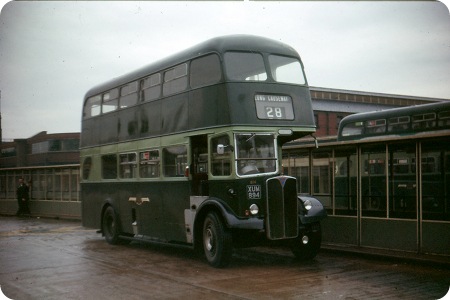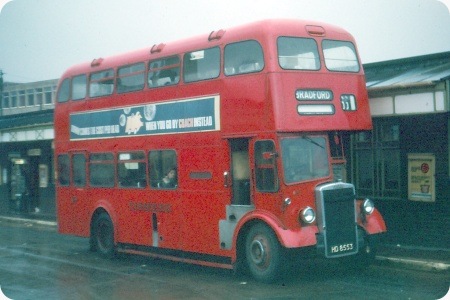Leeds City Transport – AEC Regent V – XUM 894 – 894
Leeds City transport
1957
AEC Regent V
Roe H60R
Yet another example of a Regent V with a Regent III radiator. If I remember Leeds city Transport buses were nearly all semi automatic or had clutch less gearboxes of some description probable to help them off to quick start from the bus stops.
894 is the last of a huge batch which were ordered as tram replacements. The next batch numerically were fitted with 8′ wide bodies.
Terry Malloy
The last batches of post-war LCT buses to have full three pedal "clutch and gearbox" transmission were the Crossleys, the Leyland PD1s, the sixty Leyland PD2s (NNW batch), the six "standee" single deckers (2 Guy, 3 AEC Reliance and 3 Leyland Tiger Cub) – so rather more than is generally realised !!
Chris Youhill
Hi everyone,
I meant to post this link a while ago, finally got around to it.
www.britishpathe.com/record.php?id=39972
It shows the first delivery of these vehicles to Torre Road Depot.
Terry Malloy
I think the reason for preferring clutchless transmissions, in common with several other municipal operators, was the need to retrain large numbers of tram drivers in a very short time. Far fewer people owned cars in those days, and many of those tram drivers would never have driven a motor vehicle.
What about the PD2/11s (UUA batches)? I know some of them were specials with pneumo-cyclic transmission, but I didn’t think they all were.
Peter Williamson
The last manual gearbox double deckers were the sixty "NNW" Leyland PD2s. All subsequent double deck vehicles being semi automatic of one kind or another. Thereafter all AECs and Daimlers were either three pedal pre-selector or two pedal "monocontrol." All Leylands were two pedal pneumo-cyclic with the exception of the batch of ten "RNW"s (301 -310) which were three pedal pre-selector, and were the only ones made other than the London Transport RTLs and RTWs. Passionately wishing to drive one of the latter, I booked a piece of teatime overtime out of Bramley and persuaded a bemused but helpful shift foreman to let me take 307, one of the only two remaining at the time – a great experience !!
Chris Youhill
31/07/12 – 05:43
The clutch you are referring to was a gear changing pedal (NOT A CLUTCH) they were known as preselctors, I used to love to drive them brings back memories going up Churwell Hill in the old girls, (52/53 Morley)
Roger Hopper
07/11/12 – 16:47
Snivelling out of Bramley Chris? You’re very lucky one of the PD1s wasn’t compulsory for you! When we had these at Torre Road Garage (301 – 310) we used to complain bitterly that they wouldn’t "Pull" up hills. Scott Hall Road 69 & 70 routes used to see old Hunslet MK3s flying past us. The regular Bramley drivers (used to PD1s & PD2s used to use a form of "double declutching" on these and other preselector buses – preselecting neutral between gears. Don’t know if this helped or not. Perhaps the Bramley mechanics knew how to tune them up properly as I never heard of any complaints about lack of power when the Bramley drivers got hold of them.
Bill Midgley
08/11/12 – 07:16
Most interesting memories Bill, thank you, and I had forgotten or was never aware that the "RTL"s had been at Torre Road. On that one joyous occasion that I drove 307 I found it went very well – unless I was mesmerised by the wonderful concerto of gurglings, compressed air hissings and tick over wobblings so as not to notice, and of course there were virtually no real hills on that particular piece of work, the entire outward journey from Bramley in the west to Barnbow Factory in the east being "private." The Bramley practice you mention of "double de-clutching" is completely unorthodox, baffling, and quite un-necessary, and surely can have no advantage at all – in fact it entirely defeats the object of faultless gear changes for which the system was invented !!
Chris Youhill
08/11/12 – 11:12
Ah, but it must have been harder to fiddle a CVD or CWD like. The gearchange was not an H-gate but a quadrant, so the neutral position was not between the gears. Having said that, the sheer driver-crippling vindictiveness of the change pedal has entered the annals of bus folk-lore!
Stephen Ford
10/11/12 – 10:20
Chris, these buses were new to Torre Road Garage and serviced the 69 Moortown and 70 Primley Park via Scott Hall Road services. The crews were on the TRG Rota – the precursor to getting a "Regular" on a main route.
At TRG, these were :- Dewsbury Road – Moortown – Middleton, Morley – Meanwood, East End Park Circular (included Moortown-Whitkirk & Leeds – Bradford), Lawnswood – Beeston, Half Mile Lane & Compton Road – Horsforth. Nearly everyone wanted to get onto Lawnswood because it had the best duty sheets – usually two "dinnertimes" in a late week. I worked out of TRG from 1958 – 1960 and had a "Regular" on Dewsbury Road before I went off to Headingley. When I first started, I was the youngest conductor on LCT being eighteen and two weeks! Ah! Those were the days – or maybe not!
Bill Midgley
06/01/15 – 05:42
Here’s a Pathe News clip of one of the Monocontrol Regent V’s being driven by a one-legged driver. //www.britishpathe.com/video/monocontrol-bus-aka-revolutionary-bus/query/leeds+buses
Chris Hebbron
07/01/15 – 06:26
Chris the one legged driver was John Rafferty the long time chairman of the council transport committee. The film was shot at Torre Road depot.
Chris Hough
08/01/15 – 06:43
Breath-holding shots of Alderman Rafferty climbing unaided into this Roe half-cab using his one leg and his crutch.
Joe
Quick links to the - Comments Page - Contact Page - Home Page



